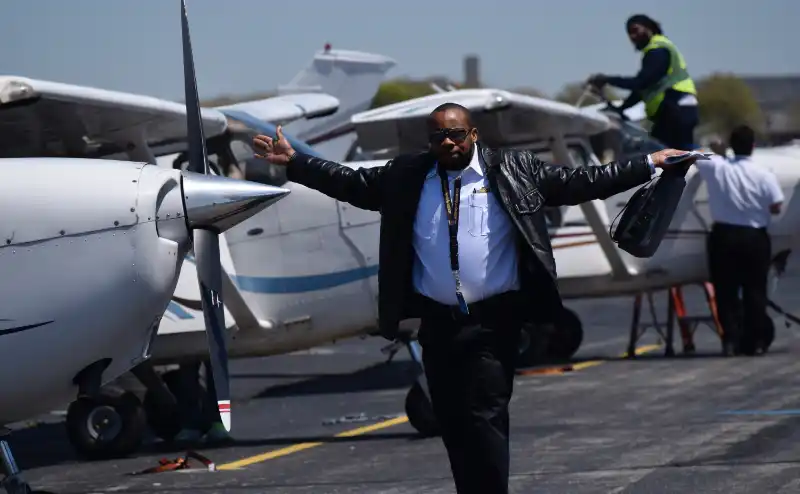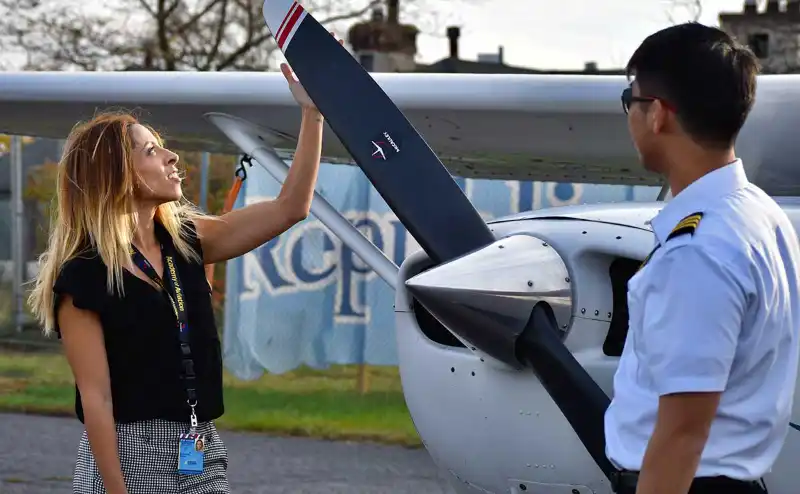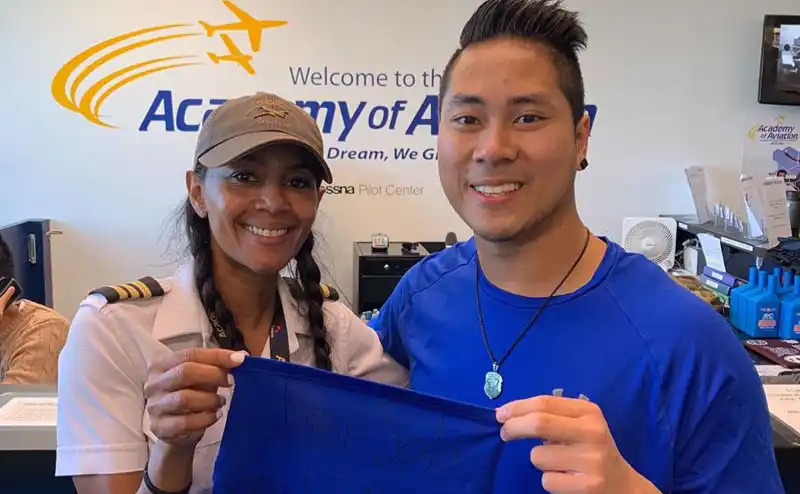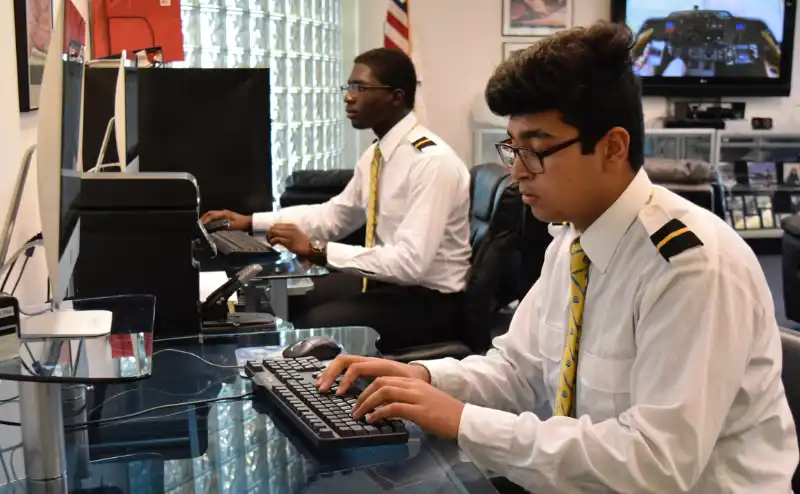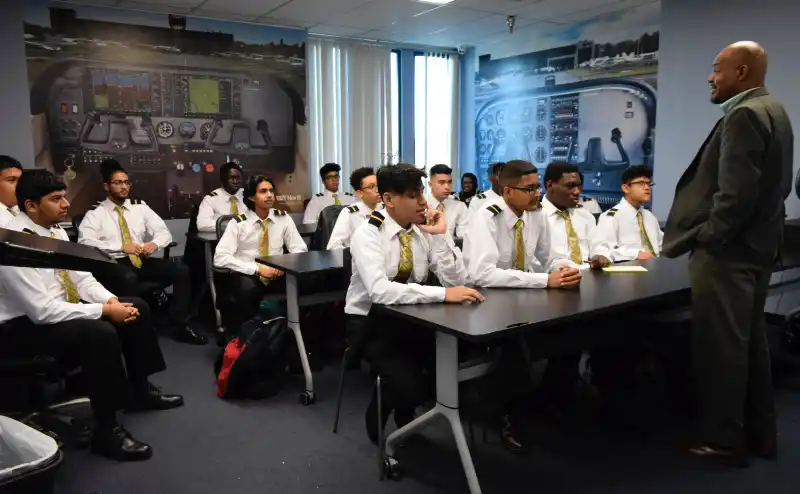I Want To Fly a Plane
Your Definitive Guide to Becoming a Professional Pilot.
Tips: We have included some inline links in our article below for your further research and reading. Visit our Frequently Asked Questions page for typical Flight Training questions and answers. This is a great resource for AOA and most other flight school students and instructors.
Request InfoYour Guide to Becoming a Pilot
If you are considering becoming a pilot for fun or for a career, it is important to
understand the educational process and choose the learning path that is right for
you.
A career pilot can fly not only for the commercial airlines, but for regional
carriers,
charter companies, the emergency service industry, search and rescue and even local
sightseeing and crop farming airplanes. Job posting sites like JSFirm and indeed display hundreds of pilot jobs, but the
commonality is
the need for professionally trained and commercially available advanced piloting
skills.
We get many potential students asking what steps they will have to take to become an
airline pilot. While a huge amount of information can be found all over the web, we
understand that it’s helpful to have it right in front of you. Let's go through a
step-by-step guide, and explain the process in a straightforward and easy to
understand list.
But, please keep this in mind: earning your commercial pilot certificate is more
than just
taking flying lessons. You will need to pass your 2nd Class medical certificate
which needs
to be renewed every 12 months, and you will need to be fluent in English, the
preferred
language for international pilots. The age requirement to start your training is 18,
and
contrary to most popular beliefs, you do not
need to
have a college degree to become a commercial pilot. Take your FAA written
exams as
soon as you feel ready, and enter the cockpit with a Certified Flight Instructor to
start
flying.
The commercial pilot certificate course track is fairly specific, and every flight
school will follow a similar curriculum. Not all flight schools are created equally,
so you want to choose one that will satisfy your goals with a balance between
cost-effective flight training time, quality training courses and engaged
instructors. Do your research, apply for loans if you are qualified, and most
importantly, talk to your Admissions and Enrollment professionals at each school you
are interested in, as many times there will be hidden costs and other complexities
in educational programs not divulged on flight school websites.
Commercial pilots always start out as private pilots. Learning the foundations of
flying is done in single engine airplanes (Cessna and Diamond) with both
conventional instruments/six-pack and glass TAA (technically advanced aircraft)
cockpits-- and then moving up to multi engine and other advanced aircraft. You will
have classroom and in-the-sky study with either one or a small group of selected
pilots and a Certified Flight Instructor (CFI).
A prerequisite to becoming a commercial pilot is at least 250 hours as PIC (pilot in
command) to earn your license. You will fly at night, in fog, in rain
and ice, go through spin
training, and become
an all-around pilot. Your mental state will be considered at all times, and you will
be
assessed on reaction and professionalism in flying and non-flying situations.
Your physical proficiency and aeronautical ability will dictate your future as a
commercial pilot.
Commercial Pilot Costs: How much does flight training cost and can I get a loan?
Learning to fly is never going to be cheap, and while you really have to shop around
to find the best cost to training ratio that works for you, you have to also do your
due diligence to choose a school that does not place money over lives. Going "cheap"
on your training can actually cost you more in the long run, as you may find
yourself undertrained and unprepared for a job flying human lives.
Fixed-cost training and further job placement is a benchmark of a well-rounded
flight school experience, and most training facilities have partnerships with
regional airlines that guarantee an immediate interview with successful students.
Many schools will hire recent graduates as CFI's so that they can practice, refine
and substantiate their skills as a pilot by teaching new students, and ultimately
earn the FAA minumim 1500 hours flight time to move on to the airlines.
If you are serious about your training, talk to an Admissions and Enrollment
Specialist at every school you'd like to check out. Is your program truly fixed cost
or are there other factors that will result in you paying more than quoted? Again,
ask your Admissions and Enrollment Specialist and learn about exactly what you are
signing when you enroll.
Be sure to look at all financial options including grants, scholarships and family
loans. Alternatively, you may be eligible for full financial aid for your flight
training, and you can ask your Admissions and Enrollment Specialist about those as
well.
Step 1: Earn Your Private Pilot Certificate
Part 141 or Part 61? You decide.
Part 141 Pilot course training syllabi have been evaluated by the FAA and follow a
strict
protocol. Both the student and the flight schools must adhere exactly to what the
FAA has
approved so there are no variations in training. The benefit, you can obtain your
FAA
Private Pilot License in fewer hours, which means shorter training time and less
money.
Part 61 Pilot courses, in comparison, are simply more flexible in how the training
is
conducted but have a higher flight hour requirement. It should also be noted that
some
airlines and Civil Aviation Authorities in other countries require Part 141
training, so
make sure you discuss your overall aviation career goals with our Admissions Team
for
guidance. You can
read
the FAA Federal Aviation Regulations for Part 61 and
Federal Aviation Regulations for Part 141 in depth here if you really want
to
understand the differences.
To earn a private pilot's license, individuals must be at least 17 years old. An FAA
medical
certificate is also required, and is obtained by being examined by an FAA-designated
Aviation Medical Examiner and demonstrating good overall health. A summary of the FAA Medical Standards is available here.
Aspiring pilots must also pass a written exam and complete at least 35 hours of
flight
training. Half of this training must be with a flight instructor, and at least 5
hours must
be in solo flight time. A practical flight test is also required, and is called a
check
ride.
Along with a minimum amount of flight hours, students need to demonstrate sufficient
skills
and knowledge to their flight instructor before they may earn an FAA private pilot's
license. This license, also known as a certificate, will allow them to fly an
aircraft and
carry passengers and baggage without compensation. Individuals will need to earn a
commercial pilot's license to get paid to transport people and property.
Academy of Aviation's Private Pilot course is both standalone and included in our
Career
Pilot track. As such, we offer both Part 141 and Part 61 pilot courses.
One of the most compelling comparisons between Academy of Aviation and a four-year
college
is the time/money factor. Unlike a full-time college commitment, we immerse you into
the
world of pilot training for the full duration of your experience. If you’ve got your
heart
set on a career as a pilot, our "First Flight
to First Officer"
Career Pilot Program will put you on a direct course to your goal in much
less time,
and for less money than a college or university.
Step 2: Earn an instrument rating and a multi-engine rating.
Part 141 or Part 61? You decide.
IFR: Operate aircraft in low-visibility situations where you cannot
solely
navigate using visual references under VFR or Visual Flight Rules. Heavy cloud
cover, heavy
rain and night flying are examples of flying IFR, or Instrument Flight Rules, and
you learn
to navigate the aircraft between navigation aids and carry out instrument approaches
to
land.
Multi-Engine: Your multi-engine commercial rating is a necessary
step for
any professional pilot who wishes to make the transition to the airlines. Your
expertise in
systems, controllability, and performance of multi-engine airplanes and Academy of
Aviation
is proud to offer the advanced abilities of the Diamond DA-42 aircraft to our
students.
Step 3: Earning a Commercial Pilot certificate. More experience and higher requirements allows pilots to legally be paid to fly.
In order to be compensated for transporting people and property, pilots should
obtain a
commercial pilot certificate. While in training, students should keep detailed logs
of both
their in-flight hours as well as their on-ground hours. A detailed article
explaining
examples of logging Pilot-In-Command time can be seen here:
"LOGGING PILOT-IN-COMMAND (PIC) TIME"
In order to receive a commercial pilot's certificate, students must pass a variety
of
medical and physical exams, an FAA written exam, and a check ride with flight
standards that
are more stringent and a knowledge level higher than that of the private pilot. Once
pilots
have obtained their license, they must pass regular physical screenings and
practical flight
tests in order to keep the status of the license up-to-date.
At Academy of Aviation, we take pride in preparing our students for all examinations
on the
way to their pilot license, and this includes making sure we cover all the required
material
for you to pass your written exams with ease and confidence. As a certified Cessna
Pilot
Center, we use Cessna developed computerized courses which closely resemble the FAA
written
exams, and we administer professionally proctored knowledge examinations in a
relaxed and
friendly environment.
Step 4: Earning Certified Flight Instructor Certificates allows pilots to earn a living flying while simultaneously obtaining the flight experience required by airlines.
• Certified Flight Instructor
Becoming a CFI gives you the qualifications to teach Private Pilot and Commercial
Single-Engine students.
• Certified Flight Instructor Instrument Rating
Your CFII allows you to teach instrument rating students both on aeronautical
knowledge and
flight training and is a great way to build on your own instrument skills.
• Multi-Engine Certified Flight Rating
As an MEI, your qualifications and credentials allow you to teach Multi-Engine
courses to
flight school students.
Step 5: Gain flight experience and earn your minimum 1,500 hours total flight time.
As an enrollee of Academy of Aviation's Career Pilot program, we encourage students
to apply
for a Certified Flight Instructor job upon graduation. A position as an AOA flight
instructor allows you to build experience and flight time; in about 18-22 months,
you can
build the flight experience required for the ATP Certificate and 1500-hour airline
hiring
minimums. The Airline Transport Pilot (ATP) certificate is the highest level of
aircraft
pilot certificate.
Your airline
transport pilot (ATP) certificate is the highest level of
aircraft pilot certificate and your key to unlocking your potential to fly for
regional and
major airlines. The experience of your instructors, the resources of your commercial
airline
pilot school and the airline relationships that your academy has to offer will be
essential
to your successful career as a pilot.
Every factor will come into play when you sign up for a flight academy. The fleet of
aircraft will be as important as the reputation of the school. A great tool to
utilize when
researching any flight school is probably how you found Academy of Aviation, i.e.
Google. Look up your
chosen flight school and read
the reviews and responses. Does the school respond to both good and bad
reviews, and do
they
explain why the review is bad and try to rectify any issue personally and
personably? Do
they deliver what they promise on their websites and in their advertisements? Actual
reviews
from actual students are what you are looking for, not embedded website quotes and
inflated
statistics.
The time it takes to become a commercial pilot is completely up to you if you choose
to
learn at a Part 61 school, but a serious career pilot student may choose to study under Part 141, which is closely monitored by the FAA.
This can be a major factor in helping you analyze the quality of the training you
will receive.
The steps you take to become a commercial pilot are laid out all over the internet,
and the
certificates you earn become more advanced in their distinction as you advance
further in
your education. A Private Pilot cannot earn money flying, while a commercial pilot
may fly
for compensation. An Airline transport pilot, or ATP, may fly scheduled flights for
an
airline after attaining your 1500 hours of flight time among other qualifications
(500 hours
of cross-country, 100 hours of night, and 75 hours instrument.) There are many ways
that a
commercial pilot student can earn money as they continue towards their ATP. Most
become
flight instructors, while other options exist such as corporate, charter and
sightseeing
jobs. It really is all about the time building and experience you acquire as you progress in
your
career.
Read more about Pilot certification in the United States.
Individuals with a Commercial Pilot's License may seek employment as a pilot
anywhere they
choose. According to job postings for aircraft pilots, employers seek pilots to fill
First
Officer positions with an airline, test new aircraft, develop flight simulation
programs,
and conduct national security missions. Employers preferred pilots with several
years of
flight experience and various pilot licenses.
Where do you go after your training with Academy of Aviation?
As we always say, call every school that you are interested in and talk to someone.
Ask the
right questions and get solid answers. Work with the school you choose to make sure
you are
getting the best flight education you can pay for, and find out if they are a
training mill
that will "place" you in a call center or at a desk after your training, or if they
will
really work with you to make you the best pilot you can be.
Academy of Aviation’s career course is a defining factor in getting you into the air
as a working pilot, and this is manifested in the seniority ranking you will earn as
you
progress through your career.
